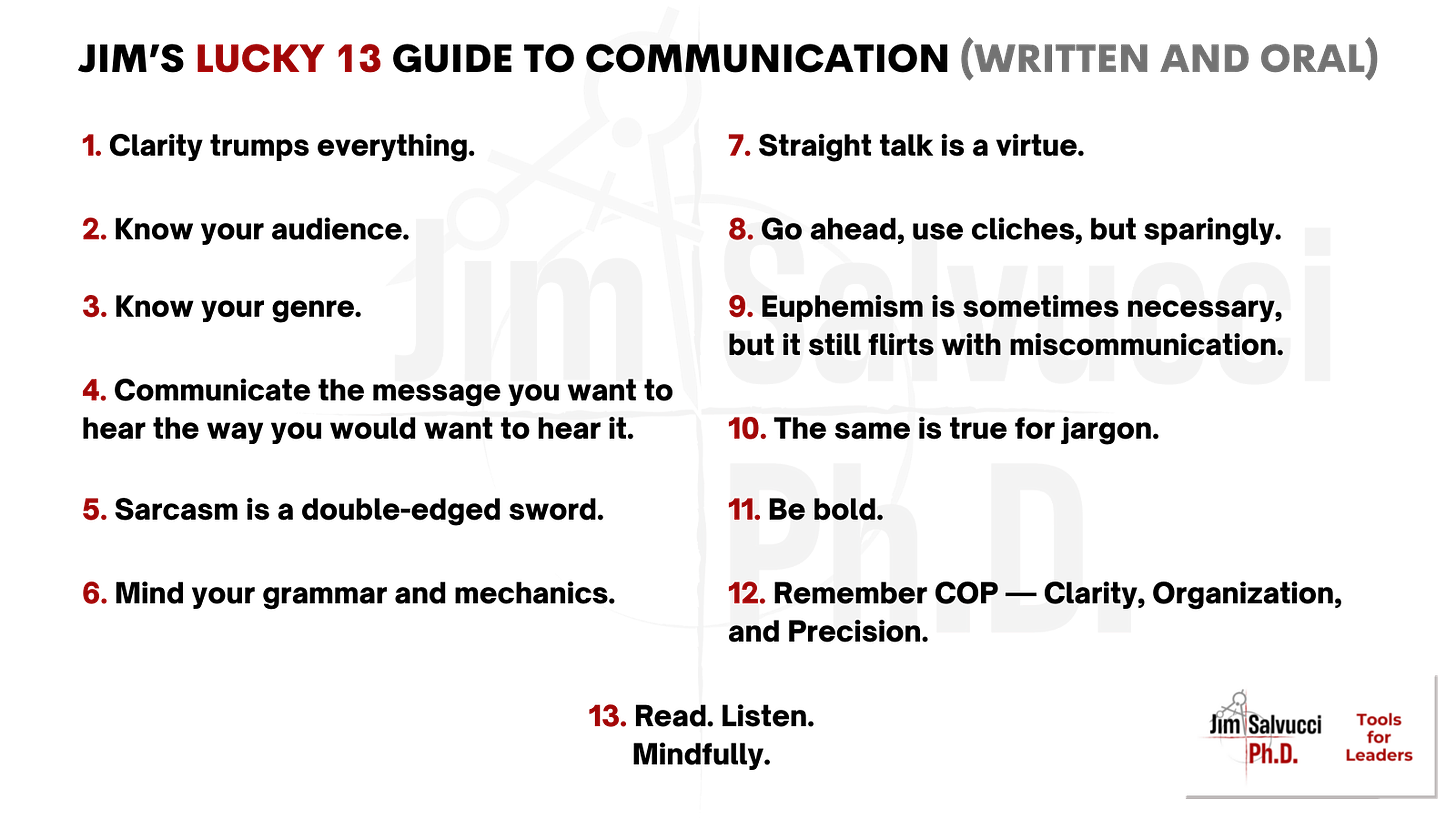It shall pass, however, for wondrous deep, upon no wiser a reason than because it is wondrous dark.
Jonathan Swift
Look. I generally detest listicles and have resisted compiling them, with one exception: my spontaneous parody of the listicles that abounded in honor of the 80th birthday of my good friend Bob Dylan.1
That said, enjoy the following listicle!
This one is on effective oral and written communication, but what I offer are not rules. They are more like guides, mere suggestions, helpful hints, noodgy nudges, and the like. After all, rules just beg to be broken. For instance, consider my personal rule that I don’t write listicles. So take that, rules!
The Lucky 13
1. Clarity trumps everything.
In this statement, “everything” includes everything on this list. The fundamental goal of communication is to get a message across, and unclear writing axiomatically does not do so. Therefore, it is imperative that you eschew obfuscation and dispense with befoggery. Then again, virtually everything on this list has to do with maximizing clarity, so this listicle is merely an abundancy of redundancy.
By the way, if you write incoherently because you figure, “Tough nuts! I’ll communicate however I like because I’m the boss,” then be aware that, while you are successfully making that point, no other point is getting through.
2. Know your audience.
Who is your audience? What do they look like? How do they dress? Are they nice? Do you think any of them might be willing to lend me some money?
Identifying your audience is key to how you will shape and tune your communication. If you are writing a blog that only a handful of friends will read, that is quite different than a blog that is open to the public and promoted on Twitter.
If you are not sure who your audience is exactly or if your audience is potentially very broad, a good trick is to imagine an audience that will absolutely and purposely misinterpret your communication. The fact is, they will.2
3. Know your genre.
“Genre” is fancy talk for format or type. Just like your audience, the format of your communication dictates many factors, including tone, length, style, etc. Writing an email is different than writing a letter, which is different than delivering a speech, and so forth.
Social media is a particularly perilous genre, especially for those of us who grew up thinking social was a word to describe disease and that telephones are utterly useless for taking photos. After all, where would you put the film? Even with that newfangled social media all the kids are into these days, though, these guides apply.
4. Communicate the message you want to hear the way you would want to hear it.
This is the writing equivalent of the Golden Rule and is therefore a matter of empathy really. We have all had to suffer through poorly communicated material, usually due to a lack of clarity, so pity your poor audience and don’t try to wow them with quasi-profound obscurity.3
Here is a simple exercise for mastering this Golden Rule of Writing.
Recall a piece of writing or other communication that you found baffling and confounding. If you ever had to read a paragraph over and over or asked the person sitting next to you, “What did she mean by that,” don’t assume the problem is with you. Instead, identify what made that communication so confusing and frustrating. Was it poorly structured? Did it use overly difficult language? Was it illogical?
Have you figured it out? Good. Now, don’t do that.
Here’s another helpful tip.
If you ever think to yourself, “oh, it’s okay. They will get what I mean,” you are wrong, just wrong. Rewrite. Partial (or wishful) communication is always miscommunication, and it’s your job to be clear. Don’t leave it to others to figure out.
5. Sarcasm is a double-edged sword.
Go for it. Use sarcasm indiscriminately. You won’t regret it.
As a card-carrying Gen X sarcasm addict, I get cut by this one all the time.
6. Mind your grammar and mechanics.
Know and respect grammar and mechanics but don’t obsess and don’t be slavish to the standards. Grammar is the rules for both oral and written language, such as how to use the parts of speech. Mechanics is the rules that apply only to written language, such as punctuation.4 Good grammar and mechanics usually aid communication, but reliance on the rules can also and should never hinder clarity or style.
For instance, you may wonder, “is it ever okay to break the rules and, say, use a sentence fragment or slang?” Sure nuff. Yup. Uh-huh.
And, while you are not obsessing over grammar and mechanics, don’t fall for bogus grammar rules. If you are not sure what I mean, go ahead and feel free to quickly look up “split infinitive.” I’ll wait.
Now look up “dangling preposition.” Got it? Good.
Now forget you ever learned about them. They are bogus rules.5
And, one more thing. Fergodsake, spare us the confusion and just use the Oxford comma!
7. Straight talk is a virtue.
Straight talk means getting to your point with as little fluff as possible. I wrote a whole essay on this once. You want to avoid passive aggressiveness, caginess, and over-wordiness, which lead to miscommunication.
One danger here is that straight talk can sometimes come across as curt and rude. Avoid being rude and turning off your audience unless you have reason to do so, such as they are all jerks. Also, be aware that emails are notoriously difficult to keep short and to the point without sounding impolite. I always try to include some pleasantries (“please,” “thanks”) and then sign off with an upbeat “best.” If you receive an email from me that does not include such courtesies, I probably just don’t like you.
Guides 8, 9, and 10 below are closely related but worth discussing separately.
8. Go ahead, use cliches, but sparingly.
Don’t get your knickers in a knot over this one. Sometimes cliches are just the thing to get the job done. A wisely used cliche can be the bee’s knees, the cat’s meow, and the right stuff. The heart of the matter is to make sure you use the right cliche at the right time so it’s not a fish out of water. And, bottom line, whatever you do, when it comes to cliches, don’t beat a dead horse.
9. Euphemism is sometimes necessary, but it still flirts with miscommunication.
Euphemism is a way to avoid saying something directly, ostensibly to soften a blow, and that is a good thing. You wouldn’t say to a grieving child, “Hey, that sucks, your mom dying in that horribly gruesome way yesterday and all.”6 But euphemisms can also be purposely misleading. For instance, how might our views of war change if instead of using the euphemism “collateral damage” we straight up said “we killed innocents.”
10. The same is true for jargon.
Jargon is specialized language that can aid internal communication in professional fields. Used externally, though, it is just showing off or, worse, participating in a conspiracy against the public. Lawyers are notorious for slinging jargon among civilians in order to wow and/or dumbfound the lay populace. My favorite legal phrase, by the way, is “to make whole,” as in, “my partners and I are confident that this generous settlement will be sufficient to make your client whole.” It just means “compensate totally.”
11. Be bold.
Surprise your audience. Thrill your reader. Assault their comfortable assumptions. Don’t be afraid to take risks in your writing to get people’s attention and your point across. That last phrase, by the way, was a slick use of zeugma, which has nothing to do with Zumba, which has nothing to do with Roomba, which has nothing to do with rumba, which is a vacuum cleaner. No, wait. That one is a dance, or is that rhumba?
Anyway, don’t be ordinary.
12. Remember COP — Clarity, Organization, and Precision.
This is a handy mnemonic acronym like FAN BOYS (for the coordinating conjunctions) or ROY G. BIV (for the colors of the spectrum).
We have thoroughly contemplated the virtues of C: Clarity. If you have already forgotten, go back to 1. And get that memory thing checked out by a professional.
O: Organization has to do with logic, and there is a really handy rule of thumb here: be logical. Can it be easier than that?
P: Precision is saying what you mean and meaning what you say. Be careful not to confuse accuracy and precision, though. Accuracy is always precise, but precision is not always accurate. Saying “it is now twelve, noon, on New Year’s Day” is precise but would be inaccurate if the real time were one in the morning sometime in July.
13. Read. Listen. Mindfully.
I considered listing this one first because it is so important, but I made it last instead so it would stand out and linger in your recollection like the first time you woke up in bed next to a dead kangaroo or like a McDonalds jingle.
The best communicators are the best audience members first. Every communication you read or listen to is an opportunity to hone your skills. If something strikes your fancy (which is fancy talk for “you dig it”), try to determine why. Can you make that part of your repertoire (which is fancy talk for “stuff”)? In contrast, if someone’s attempt at communication vexes you (which is fancy talk for “pisses you off”), figure out why. How can you avoid doing the same thing?
—
Here’s hoping you find something useful here. If you take away one thing from this listicle, let it be that rules, guides, suggestions, and the like are supposed to enhance your communication. Never let them hinder your communication. And let me reemphasize 11: Be bold.
I know that I missed your favorite communication tip, so let me know your additions by email or, preferably, in the comments. If you disagree with anything here (and I’m sure some do), let me know as well. I look forward to the conversation.
—
Share your thoughts on this topic or participate in a discussion by leaving a comment below or by contacting me directly by email:
You must register with Substack to leave a comment, which stinks but is painless and free.
I look forward to hearing from you.
Post this essay on social media or send it by email to someone you want to inspire/annoy.
Subscribe to receive my weekly newsletter and special editions directly to your mailbox.
You can improve your ability to achieve your organization’s mission.
Visit my website and reach out to me to learn how.
We have never met.
Whoever first suggested that if you are nervous about giving a public speech you should picture your audience in their underwear never attended an academic conference. Jeez!
Jonathan Swift’s observation on profundity in the conclusion of his superlative A Tale of a Tub (1704) is apt: “I conceive, therefore, as to the business of being profound, that it is with writers as with wells. A person with good eyes can see to the bottom of the deepest, provided any water be there; and that often when there is nothing in the world at the bottom besides dryness and dirt, though it be but a yard and half under ground, it shall pass, however, for wondrous deep, upon no wiser a reason than because it is wondrous dark.”
Do not confuse the mechanics of communication with those guys who say you need a new transmission or something every time they have a payment due on their vacation home.
Before you send me a link to Grammarly or an ill-informed writing page of some university website claiming these rules are not real but should be followed in “formal writing,” consider the absurdity of that assertion. Bogus is bogus, and just because some pompous pedants push bogus rules does not magically transform them into the standards for formal English.
When my mom died, my next-door neighbor, in his unmistakable New York accent, consoled me with, “Hey. Sorry about all that shit,” which was his version of a euphemism. It was sort of sweet.
















The Lucky 13 Guide to Communication (Written and Oral)